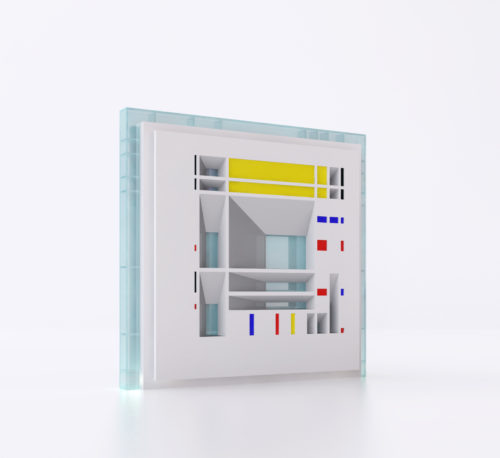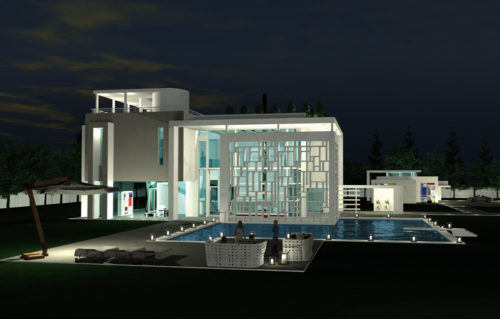INSIDE MONDRIAAN
INTRODUCTION OF THE PROJECT
Transposition of matter of an abstract view – from Painting to Architecture
by Carolina Lio – ( 2014 )
In 2011, Francesco Visalli saw a retrospective of Piet Mondrian (Pieter Cornelis Mondriaan) at the Vittoriano in Rome and was struck by title “The perfect harmony”. Actually, he found in the whole show – and in general in all the pieces by the Dutch master – a remarkably simple and yet revolutionary perfection of forms, balances, colors as well as the equilibrium in the relationship between solids and voids . From this sudden fascination was born the project “Inside Mondriaan”, a conceptual research.
Mainly, it is a theoretical and technical study in which Visalli takes into account a corpus of 47 selected Mondrian’s paintings belonging to his abstract period, therefore made between 1917 and 1944. Through a series of variations on the theme, intended to enter into the dynamics of the construction of those specific works, he comes to the development of 340 “visitations”. In a first stage, they exist only in digital form with the intention to materialize them in real paintings and then shift on a three-dimensional plane of exponential sizes, from the sculptural model to the monolithic installation up to architecture. The project can also be applied to the design, but still considering that the all the infinite, different applications of realization are secondary to the genuine intent of the project, which aims to study Mondrian’s spatial and chromatic dynamics and the compositional grammars of the De Stijl movement applied to a contemporary dimension.
The two starting points of “Inside Mondrian” were the understanding of Mondrian’s gradual addressing towards a simplification of his work, seeking harmony in essentiality, and the comprehension of the main rule of his most mature and balanced pieces: the grid made by black straight lines, both horizontal and vertical, which create spatial planes, empty or filled exclusively by the three primary colors (yellow, red and blue). Francesco Visalli’s actions go in the direction of exploring this purity, creating works that re-experience in reverse the path of cleaning obtained by Mondrian. Through chromatic inversions, distortions, stratifications and shades of color, he imagines the negative face of each artwork and tries to go back in its hypothetical history, retracing in reverse the simplification obtained by Mondrian and looking for the “formulas” of his perfect and basic compositions with an eye almost alchemical and mathematical.
The study starts from the basic artwork that Visalli calls “00”, which is the same seen during the Mondrian’s retrospective in Rome and from which springs the whole idea of the project: “Composition with large red plane, yellow, black, gray and blue” – 1921. This is the first image he digitally reworks, the first of 47 works analyzed through a set of specific actions: exploring, studying, penetrating, inverting, distorting, transforming. Each work is, firstly, enlarged with elaborations conceived doubling its original size and, secondly, split into its two main components: color planes and geometric pattern.
At this point, the operations performed to create the variations of each work follow a precise process in nine steps
- detachment of the geometric pattern from the canvas, creating the projection of a shadow on the surface below.
- chromatic inversion of the work, an internal reversion where white becomes black and vice versa, red turns into green, yellow turns into violet and blue into orange.
- elimination of any chromatism from the work and its reverse, turning it into shades of gray due to the physics assumption that colors are nothing more than frequencies subject to our physical perceptions and that, consequently, do not exist as intrinsic qualities of the elements.
- distortion of the geometric grid into curved lines through a “circular distortion” that starts from the center and fades reaching the outer corners of the works, both keeping the original color and applying the effect on the negative piece.
- union of the third and fourth point, which is the circular distortion applied to the works in grayscale.
- total emptying of the color on the distorted works, using just white and black, plus their inversion.
- restoration, from the step 6, of the geometric pattern.
- removal of the black and white planes, like puncturing the work and obtaining a hollow structure formed by the geometric pattern highlighted by a shadow that emphasizes the idea of internal emptiness.
- reintroduction of the color that is as recessed into the perforated structure, while the originally white spaces remain as empty.
It’s from this point that any further evolution – or involution – necessarily abandons the pictorial side and meets its three-dimensional aspect. This stops being a pure visual impression given by the shadows and takes shape in real sculptural objects or even in architectural designs. Visalli indeed duplicates the dimensions of these bodies up to imagine a hypothetical city built with the laws of the De Stijl movement, a city such as might have existed in Mondrian’s visionarity, which could have been his ideal model to be portrayed in subsequent steps, more and more simplified until reaching a disarming and perfect fundamental solution.

Through the project “Inside Mondriaan”, therefore, Francesco Visalli’s intention is to rebuild this solution backwards, retracing Mondrian footsteps with a route proposal, trying to theorically recreate his cleaning process, rationalizing and putting into equation the harmony achieved by the analyzed artworks.
